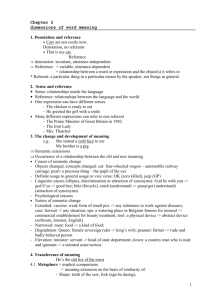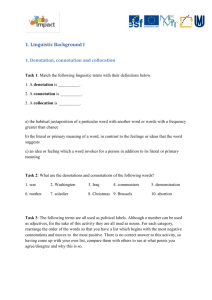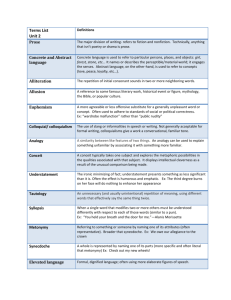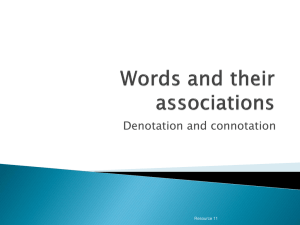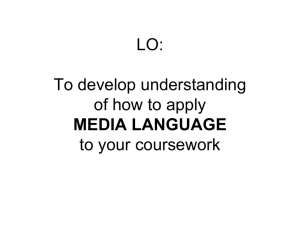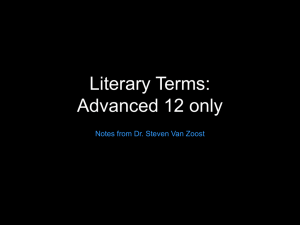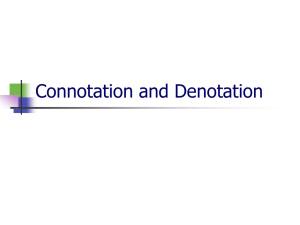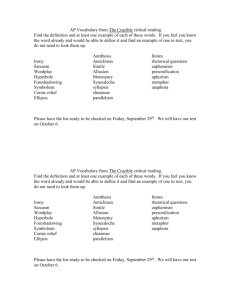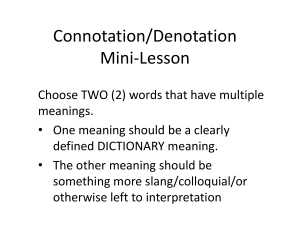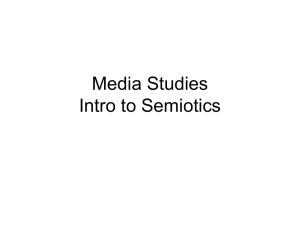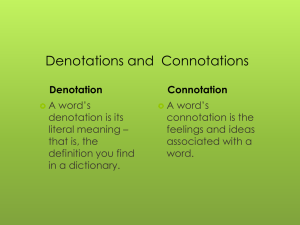Linguistics and semiotics
advertisement
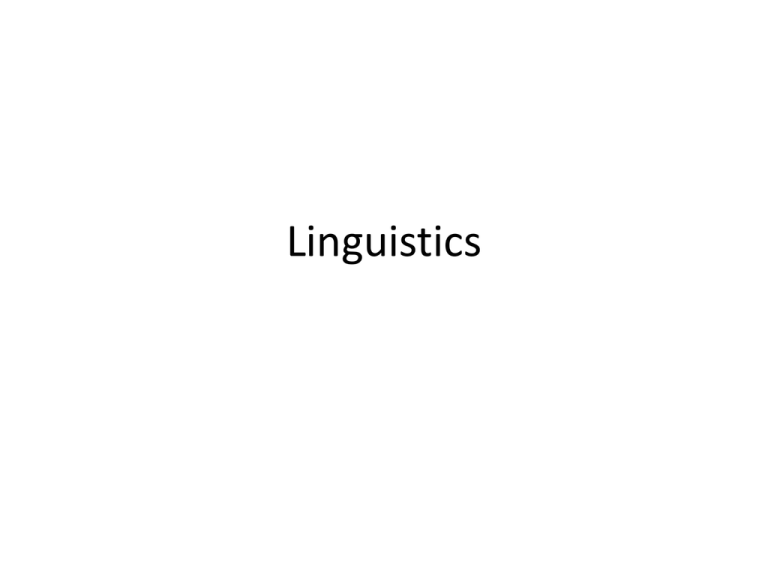
Linguistics Linguistics • Linguistics is the scientific study of language. • Because of the variety of influences on language, linguistics influences and is influenced by a wide variety of disciplines. What is Language? • A system of communication using sounds or symbols that enables us to express our feelings, thoughts, ideas, and experiences The Universality of Language • Everyone with normal capacities develops a language & follows its rules (more or less!) – Language development is similar across cultures – babbling at 7 months, a few meaningful words by 1st Birthday, first multiword utterances occur about age 2 • Language is universal across cultures – there isn’t a single culture without a language – Languages are “unique but the same” – different sounds/words/grammar, but they all have words that are nouns & verbs, all languages include a system to make things negative, ask questions, and refer to past & present What is Language? • We can create unique sentences because the structure of language is 1. Hierarchical • Because it consists of a series of components that can be combined to form larger units 2. Governed by rules • • Allow us to know the appropriate ways to organize statements Grammar – a set of rules for the production and use of language units Grammar • Descriptive rules – rules that show typical use of a language – Example: “To boldly go where no one has gone before.” • Prescriptive rules – rules that suggest how a language should be used – Example: “To go boldly where no one has gone before.” Psycholinguistics • • The psychological study of language Goals: 1. Competence (Comprehension) – how do we understand? 2. Performance (Speech production) – how do we produce language? 3. Acquisition – how do we learn language? From Akmajian and Demers (2010) based on Chomsky (1972) From Akmajian and Demers (2010) based on Chomsky (1972) From Akmajian and Demers (2010) based on Chomsky (1972) Pranks for Science! • McGurk Effect (McGurk & McDonald, 1976) • Speech perception is based on both visual and auditory information. • When visual and auditory information do not match, phonemes may be perceived incorrectly. – Example: Simultaneous visual presentation of the syllable /ba/ and auditory presentation of the syllable /ga/ will result in a perception of the syllable /da/ Pranks for Science! • Garden-path sentences – “The secretary applauded for his efforts was soon promoted.” – “Fat people eat accumulates.” – “The horse raced past the barn fell.” Pranks for Science! • Garden-path sentences – “Because he ran the second mile went quickly.” Reinterpretation Something wrong First interpretation AMBIGUITIES IN NEWSPAPER HEADLINES (from The Telegraph Herald, Dubuque, Iowa, Nov 13, 1990) NEW ENVIRONMENTAL CHIEF SETTLES IN WELL (THE DAILY INDEPENDENT, ASHLAND, KENTUCKY) LEXICAL AMBIGUITY IS “WELL” A NOUN OR AN ADVERB? POLICE NAB STUDENTS WITH PAIR OF PLIERS (JOURNAL AND COURIER, LAFAYETTE, INDIANA) SURFACE AMBIGUITY DID THE POLICE OR THE STUDENTS HAVE THE PLIERS? RALPH STEINER DEAD; A STILL PHOTOGRAPHER (THE NEW YORK TIMES) LEXICAL AMBIGUITY “STILL” MAY REFER TO PHOTOGRAPHY OR DEATH A few more examples... • • • • • • • • • • • • • EYE DROPS OFF SHELF KIDS MAKE NUTRITIOUS SNACKS STOLEN PAINTING FOUND BY TREE DEALERS WILL HEAR CAR TALK AT NOON MINERS REFUSE TO WORK AFTER DEATH MILK DRINKERS ARE TURNING TO POWDER COMPLAINTS ABOUT NBA REFEREES GROWING UGLY POLICE BEGIN CAMPAIGN TO RUN DOWN JAYWALKERS GRANDMOTHER OF EIGHT MAKES HOLE IN ONE HOSPITALS ARE SUED BY 7 FOOT DOCTORS ENRAGED COW INJURES FARMER WITH AX SQUAD HELPS DOG BITE VICTIM HERSHEY BARS PROTEST Semiotics Semiotics for Saussure • Semiotics – study of signs • Signs – made up of signifier and signified – Signifier – sound-image (it’s the impression a person gets from an object – in our language system a person knows how it sounds) – Signified – the concept that comes to mind • Signs are arbitrary Adapting Saussure His theories have been adapted more generally as the relationship between material objects and meaning – not so linguistic or focused on words and mental impressions. Sign – Signifier – the material part (form of expression) – Signified – the concept or meaning (form of content) • M - mmmmmm • Moose - Interpreting Signs Denotation & Connotation • Denotation - literal and detailed description of a meaning of a word or object. • Connotation - cultural meanings and myths connected to words and things. Interpreting Signs Denotation & Connotation More Denotation and Connotation Three big terms: Metaphor, Metonymy, & Synecdoche • Synecdoche – when a part represents a whole or a whole represents a part. – McDaniel won the football game. – The police thought tasing a five year old was a good idea. – Women are smarter than men. Synecdoche is visual and pranky Metonymy • Metonymy – communicates through association. Substitutes or allows one thing to stand for another. – He got a pink slip and was really depressed. – The material girl is going to release another album. – You just can’t fight city hall. Metonymy is visual • Metonymy – communicates through association. Substitutes or allows one thing to stand for another. Metaphor • Metaphor - helps us understand what something is by comparing it to something else. It is a way of conceiving of one thing in terms of another for understanding. – The internet is a web. – Love is a game. – School is jail. Semiotic Perspective of Language and Speech and Disciplines • Language – a social institution that expresses ideas by using signs, whose meanings are based on convention (Berger 21) • Speech – the ways that individuals use a language (Berger 20) Language and Speech in Football Language Speech Social institution Personal choices All teams available Who a person cheers for Dialects Defense/Offense/Special Teams and all the plays they may have Sentence The choice of a play (Hail Mary or Cover 2) Grammar What combinations you can put together on the field, rulebook, rules for combining players. Dictionaries Playbooks Language and Speech in Rhetoric Language Speech Social institution Personal choices All theories available in rhetoric What theories a person selects to use Dialects Aristotilean, Platonic, Burkean, Weaverian Sentence An article/essay on rhetoric Grammar Rules for combining dialects. Rules for citation. Rules for tone and formality. Dictionaries MLA handbook, Rhetoric for Dummies, Wikipedia
